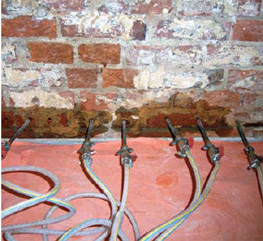|

The
Preferred System
Over the past twenty years a wide range of damp proofing systems have
been used to prevent rising damp. These include both practical and obscure methods;
some which have been short lived, due to difficulty in installation, dubious
effectiveness and in some cases detrimental effects to the treated
building.
Pressure injection chemical damp proof courses have been successfully used
since 1960 and. is a nominated method on restoration projects throughout
the world.
Dyco-damp
proofing introduced the injection system to Australia in 1976.
The Westox Injection System has consistently been used by Restoration
Bodies on many of Australia's oldest buildings, ranging from Victorian Terraces
to major conservation projects.
The advantage of this injection system includes the level of installation which
may be lower than some other commonly used methods This provides protection to
the skirting boards and can avoid dampness bridging through the new plaster.
Speed and cleanliness of installation are two other factors in arriving at an
objective choice.
Approved Applicators of the Westox Chemical Damp proof Courses carry out
a careful survey of the problem and provide a written report and quotation.
As an accurate diagnosis is critical in making an appraisal of any
dampness problem, an electronic meter is used to assess moisture content and to
identify it's source. It is not uncommon to see properties treated at great
expense for rising damp when the problem could be as simple as a broken down
pipe or other minor repair.
After the installation of the new damp course, the walls will gradually
dry out. Depending on the moisture content and the thickness of the walls, this
could take excess of one year. The replacement of all damp affected plaster is
essential to prevent secondary dampness.
Salt contamination of the old plaster is caused by the moisture
containing salts, rising up through the capillaries of the brickwork from the
ground below.
These salts build up in the plaster over a period of the time and
attract airborne moisture. It is the expansion and contraction of these salts
which cause the familiar rising damp symptoms of eroding and blistering paints
and plaster. The major proportions of the salts are removed with the old
plaster. The new render is designed to allow the passage of water vapour, so
that residual moisture can dissipate from the wall With the use of a special cement
additive called Westox salt retarder, the old plaster can be replaced soon
after the installation of the new damp-proof course.
On the commencement of a typical rising damp project the applicator
removes the original skirting, which may be refitted after the installation of
the chemical damp-proof course and the completion of re plastering. In some
cases the skirting may be rotten and require replacement.

The damp affected plaster is then removed to expose the brick or stone
After selecting the course of brick or stone which will become the new damp-proof
course, a series of 10mm holes are drilled at an appropriate depth and space.
The injection lances are then introduced into the holes and a seal is
formed by a rubber expansion washer which holds the lance firmly into the brick
or stone.
The selected Westox Injection Fluid is then pumped via flexible tubing
into the brickwork and the fluid, now under pressure is forced through the
capillaries of the brick or stone until it is visually evident that saturation
has taken place.
The lances are then removed and the procedure is repeated progressing
along the wall to be treated.
The injection fluid continues to penetrate through masonry and mortar
joints by capillary action for approximately 24 hours. After the full thickness
of the wall is injected the continuous saturated section of masonry will become
the new damp-proof course. After a short drying period (7-10 days) the render-plaster
may be replaced to complete the job
The Westox Chemical Damp-proof Course is covered by a written 20 year warrantee
but only applies if the work is undertaken by a Westox Approved Contractor.
TOP Technical
Specifications
Standard
specification
(Pressure
Injection)
Remove Skirtings where applicable. Remove damp effected plaster to a
height of 400mm above the highest point at which dampness can be detected (a
suitable moisture meter should be used.)
Drill 10mm holes in the brick or stone to predetermined depths and
spacing.
Introduce injection lances into holes and activate expansion washers.
Proceed with injection through multi lance harness until it is visually
evident that full saturation has been achieved.
Usage
The rate of fluid used will be relative to the porosity of the materials
and the thickness of the walls. As a general guide the fluid requirements are
in the region of 1.5 to 2 litres per 110mm thickness of wall per lineal meter.
Replastering
After the "drying out" period (minimum of seven days) the
walls are to be replastered to the following specification.
Mixing Water
40 Parts fresh water to 1 part Westox Salt Retarder (e.g. 500mls per 20
litres water)
Cement Mix
1 part OP Cement, 3 parts washed sharp plastering sand.
Note: Important do not add lime, plasticiser or any other additives.
General purpose cement must only be used (not builders cement)
Mix to a workable consistency and apply at a minimum thickness of 10mm.
After overnight drying the wall may be set finished with a mixture of
hard wall plaster and hydrated lime.
Should a sponge finish of render be required, a second coat of render must
be applied on the same day as the salt retarding coat. This finish coat is to
be of 6 sand, 1 cement, 1 lime.
After adequate drying either the original or replacement skirtings may
be fitted.
Precautions and First Aid
A Westox 50 Material Safety Data Sheet should be provided to all persons
handling the product.
Storage
Store in a cool dry place.
TOP
|



![]()
![]()

![]()
![]()
![]()
![]()
![]()
![]()
![]()
![]()
![]()
![]()